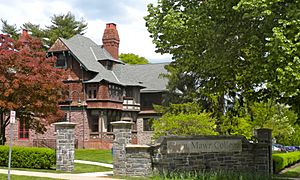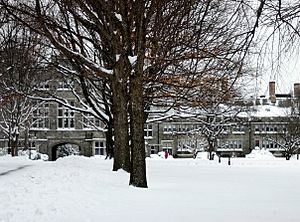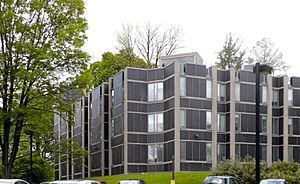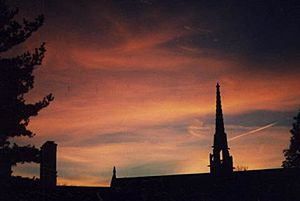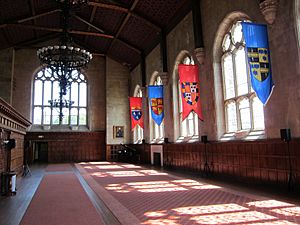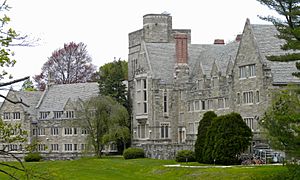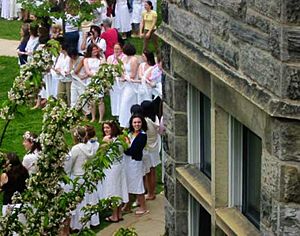Bryn Mawr College facts for kids
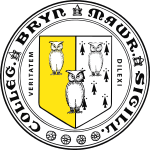 |
|
| Motto | Veritatem Dilexi (Latin) |
|---|---|
|
Motto in English
|
I Delight in the Truth |
| Type | Private women's liberal arts college |
| Established | 1885 |
|
Religious affiliation
|
None, formerly Quaker |
|
Academic affiliations
|
|
| Endowment | $1.18 billion (2021) |
| President | Wendy Cadge |
| Provost | Tim Harte |
|
Academic staff
|
160 full-time, 41 part-time (2019) |
| Students | 1,677 (fall 2023) |
| Undergraduates | 1,360 (fall 2023) |
| Postgraduates | 317 (fall 2023) |
| Location |
,
,
United States
|
| Campus | Suburban, 135 acres (55 ha) |
| Colors | Lantern’s Glow and White |
|
Sporting affiliations
|
NCAA Division III – Centennial Conference |
| Mascot | Owl |
|
Bryn Mawr College Historic District
|
|
| Location | Morris Ave., Yarrow St. and New Gulph Rd., Bryn Mawr, Pennsylvania |
| Area | 49 acres (20 ha) |
| Built | 1885 |
| Architect | Multiple |
| Architectural style | Late Gothic Revival, Gothic, Collegiate Gothic |
| NRHP reference No. | 79002299 |
| Added to NRHP | May 4, 1979 |
Bryn Mawr College is a private school for women in Bryn Mawr, Pennsylvania. It is a liberal arts college, which means students can study many different subjects like science, history, and art. The college opened in 1885.
Bryn Mawr is one of the famous "Seven Sisters" colleges. This was a group of top schools for women in the United States. The college was one of the first in the country to allow women to earn advanced degrees like a PhD. Today, about 1,350 undergraduate students and 450 graduate students attend Bryn Mawr.
Contents
History
Bryn Mawr College was founded in 1885. Its name means "large hill" in the Welsh language. The school was started with money from Joseph W. Taylor, and its first president was James Rhoads.
The college was originally connected to the Quakers, a religious group that believes in equality. However, by 1893, it was no longer tied to any specific religion. From the beginning, Bryn Mawr was a leader in women's education. It was one of the first colleges to offer graduate degrees to women.
In 1931, the college began to accept men into its graduate programs. The main undergraduate college remains focused on women's education.
Welcoming Transgender Students
In 2015, Bryn Mawr College updated its rules to welcome transgender women to apply. The college believes that ideas about gender can be flexible. It also accepts students who were assigned female at birth but do not identify as either male or female.
College Presidents
Bryn Mawr has had ten presidents since it opened:
- 1885–1894 James Rhoads
- 1894–1922 M. Carey Thomas
- 1922–1942 Marion Edwards Park
- 1942–1970 Katharine Elizabeth McBride
- 1970–1978 Harris Wofford
- 1978–1997 Mary Patterson McPherson
- 1997–2008 Nancy J. Vickers
- 2008–2013 Jane Dammen McAuliffe
- 2013–2024 Kimberly Wright Cassidy
- 2024–present Wendy Cadge
Campus
The college's campus is beautiful and full of nature. It was designed by famous landscape architects Calvert Vaux and Frederick Law Olmsted. The campus is also an official arboretum, which is like a museum for trees.
Student Dorms
Most students live in dormitories on campus. Many of the older dorms have a special style of architecture called Collegiate Gothic. This style was inspired by old universities in England, like Cambridge University.
The dorms are named after towns in Wales, such as Brecon, Denbigh, Merion, Radnor, and Pembroke. Other dorms include Erdman Hall, which has a modern design by architect Louis Kahn. Students can also live in special houses like the Enid Cook '31 Center, which is a center for Black culture.
Important Buildings
The campus has several historic and important buildings.
Marjorie Walter Goodhart Theater
This theater is where students and visiting artists perform. It has a large main stage and smaller spaces for performances. The building has towers, carvings, and fancy ironwork in the gothic revival style.
Old Library
This building used to be the main library. Its Great Hall is a huge, beautiful room used for lectures, concerts, and meetings. The building surrounds a courtyard called "The Cloisters." The ashes of the college's second president, M. Carey Thomas, and the famous mathematician Emmy Noether are in the Cloisters.
The building was once named after M. Carey Thomas. However, students protested because some of her beliefs were seen as racist and unfair. In 2018, the college renamed it the "Old Library" to show its commitment to being a welcoming place for everyone.
Rhys Carpenter Art and Archaeology Library
Named after a professor of archaeology, this library opened in 1997. It holds the college's collections in art history and archaeology. The building has a modern design with a four-story open area at its entrance.
What Students Learn
Bryn Mawr is a top-ranked liberal arts college. Students must take classes in the social sciences, natural sciences, and humanities. They also have to study a foreign language for one year.
A special class for first-year students is the Emily Balch Seminar. These small, discussion-based classes help students improve their thinking and writing skills.
Some of the most popular subjects to study at Bryn Mawr are:
- English
- Biology
- Psychology
- Mathematics
- Computer Science
Fun Traditions
Bryn Mawr has many fun traditions that students celebrate all year.
- Parade Night: On the first Friday of the school year, new students run to Taylor Hall while older students cheer and throw confetti.
- Lantern Night: In the fall, first-year students are given special lanterns in a ceremony. This tradition symbolizes passing knowledge from one generation to the next.
- Welcome the First Years Week: In the spring, first-year students (called "buds") are paired with an upperclassman (their "rose"). The week is full of fun activities and surprises.
- May Day: On the Sunday after classes end, students celebrate the spring. The day includes a parade, dancing around a Maypole, and student performances.
Students also have fun superstitions. For example, they leave offerings to a statue of the goddess Athena for good luck on exams.
Athletics
Bryn Mawr's sports teams are called the Owls. The owl is a symbol of Athena, the Greek goddess of wisdom. The teams play in the Centennial Conference at the NCAA Division III level.
Sports at Bryn Mawr include:
- Badminton
- Basketball
- Cross country
- Field hockey
- Lacrosse
- Rowing
- Soccer
- Swimming
- Tennis
- Track and field
- Volleyball
The badminton team has won national championships.
Famous Graduates and Teachers
Many famous and successful people have graduated from or taught at Bryn Mawr.
Graduates
- Drew Gilpin Faust: The first woman to be president of Harvard University.
- Katharine Hepburn: A famous actress who won four Academy Awards.
- Emily Greene Balch: Winner of the Nobel Peace Prize.
- Marianne Moore: A well-known modern poet.
- Alice Rivlin: The first director of the Congressional Budget Office.
- Candace Pert: A neuroscientist who helped discover how pain signals work in the brain.
- Michelle Zauner: A musician who performs as Japanese Breakfast.
Teachers
- Woodrow Wilson: Taught at Bryn Mawr before he became President of the United States.
- Emmy Noether: A brilliant mathematician who made important discoveries in algebra.
- Richmond Lattimore: A famous poet and translator of ancient Greek texts.
- José Ferrater Mora: A Spanish philosopher.
See also
 In Spanish: Bryn Mawr College para niños
In Spanish: Bryn Mawr College para niños




